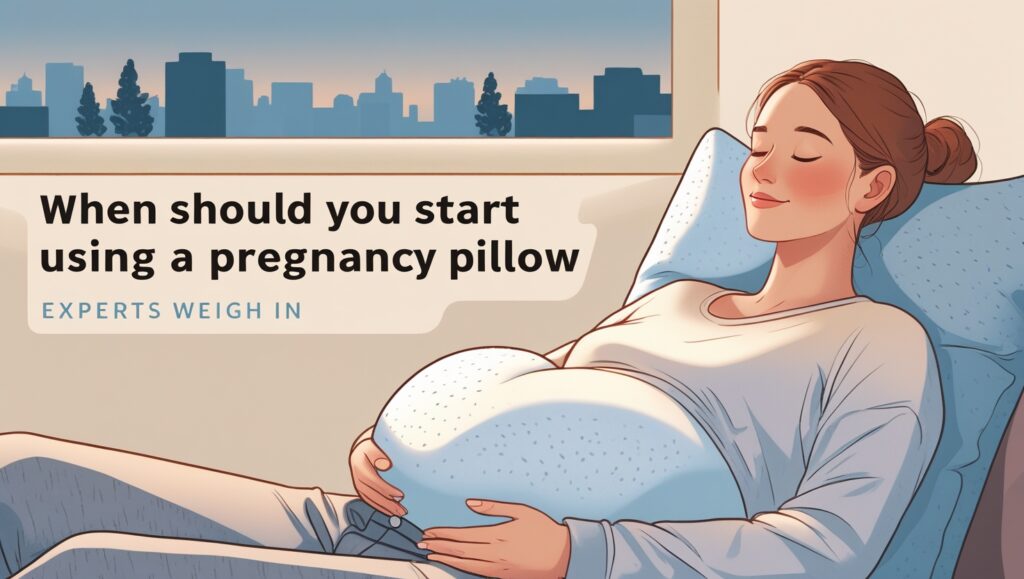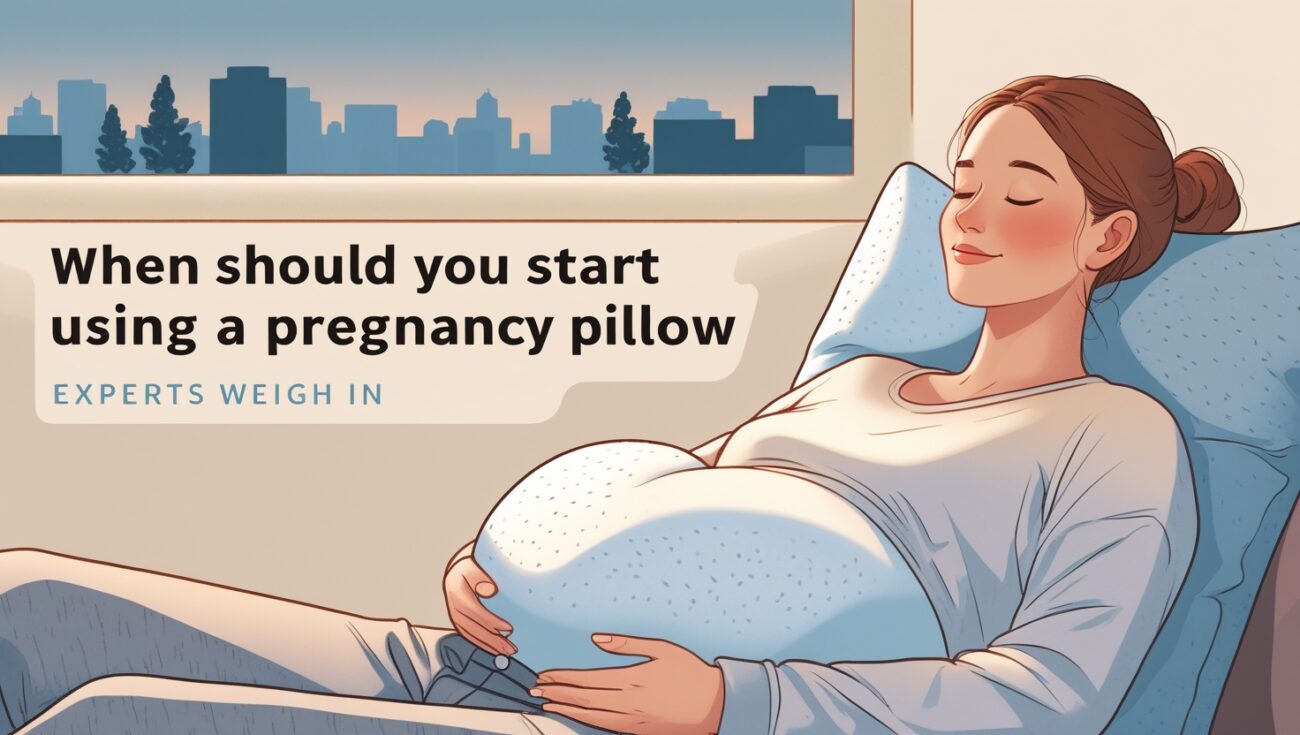When Should You Start Using a Pregnancy Pillow? Experts Weigh In
Experts recommend starting to use a pregnancy pillow as soon as you begin feeling discomfort—typically in the second trimester around weeks 14–16. However, you can start earlier if you have trouble sleeping, back pain, or want to maintain proper alignment during pregnancy.

Table of Contents
When I was newly pregnant, I kept wondering if I was jumping the gun by looking at maternity pillows so early. The truth is, there’s no strict “right time.” Every pregnancy is different, but experts agree that using one before discomfort gets bad can make a huge difference.
Here’s what doctors, chiropractors, and sleep specialists say about when to start using a pregnancy pillow—and why sooner can be better.
Early Use for Preventive Support
Many experts suggest starting before you feel aches, especially if you’re a side sleeper or prone to hip and lower back pain. Getting used to the pillow early helps you find your ideal setup before your belly grows.
- The U-Shaped Full-Body Pregnancy Pillow is perfect for starting early.
Second Trimester Comfort Boost
Most women begin to notice discomfort in the second trimester when weight distribution changes. This is when a pregnancy pillow becomes almost essential for restful sleep.
- I loved the C-Shaped Pregnancy Pillow for side sleeping.
Starting Late Still Helps
Even if you wait until the third trimester, a maternity pillow can still provide much-needed relief. It helps you stay in a safe sleeping position and eases late-pregnancy pressure points.
- The Ergonomic Side Sleeper Maternity Pillow worked wonders for me in the last weeks.
Signs It’s Time to Start
Experts agree you should start if you’re waking up sore, rolling onto your back at night, or having trouble staying comfortable in one position. These are signals your body needs extra support.
- The Adjustable Firmness Pregnancy Pillow can adapt as your needs change.
Final Take: You don’t need to wait for pain to start before using a pregnancy pillow. Beginning earlier can help you sleep better, prevent aches, and make the transition into later pregnancy much smoother.
Some obstetricians recommend starting as early as the first trimester if you already have lower back pain or hip discomfort. Even though your belly hasn’t grown much yet, hormonal changes can loosen ligaments, making joints more vulnerable to strain.
- The Small Wedge Pregnancy Pillow is a great starter option for early support.
Sleep specialists point out that using a pillow early can train your body to stay in a healthy side-sleeping position, which becomes more important as pregnancy progresses. Building this habit before your bump grows makes it easier to stick with later.
- The Side Sleeper C-Shaped Pillow works perfectly for this.
Chiropractors say that one of the best reasons to start early is spinal alignment. Even a few weeks of sleeping in poor positions can cause lasting discomfort, so prevention is key.
- I used the Ergonomic U-Shaped Pregnancy Pillow for full support.
Physical therapists add that using a maternity pillow can help prevent muscle tension from building up, especially in the hips, thighs, and lower back. This makes daily movement and exercise easier.
- The Full-Body Maternity Pillow helped me wake up without stiffness.
Some midwives encourage their clients to start using a pillow as soon as they notice sleep disruptions. Pregnancy hormones can already affect sleep in the early weeks, and comfort plays a huge role in minimizing fatigue.
- The Cooling Bamboo Pregnancy Pillow kept me comfortable during warmer nights.
Another reason to start early is to get used to the size and shape of the pillow. Large maternity pillows can feel bulky at first, so adjusting before you’re heavily pregnant makes them easier to use.
- I got used to mine with the Adjustable Fill Pregnancy Pillow.
Even if you don’t use a full-size pregnancy pillow in the beginning, adding smaller supports under your belly, behind your back, or between your knees can make a noticeable difference.
- The Compact Travel-Friendly Pregnancy Pillow was my go-to for quick comfort.
Experts also highlight the benefit of reduced tossing and turning. Once you find a comfortable position with the right pillow setup, you’re less likely to shift around at night, which means better, deeper rest.
- The Plush U-Shaped Pillow kept me in place all night.
For those with pre-existing conditions like scoliosis or sciatica, starting with a pregnancy pillow early can prevent flare-ups. The right support can relieve nerve pressure and promote better posture.
- The Sciatica Relief Pregnancy Pillow worked wonders for my lower back pain.
Another expert tip is to combine a pregnancy pillow with other sleep aids, such as blackout curtains or a white noise machine, to create the ideal sleep environment from the start.
- The White Noise Machine became a nightly must-have for me.
Starting earlier also helps with mental comfort. Knowing that you’ve done something to improve your sleep can reduce stress and make it easier to wind down at night.
In the end, the consensus from experts is clear—there’s no such thing as starting too soon if you want to protect your body and enjoy better rest throughout pregnancy.
I found that starting with a pregnancy pillow earlier than I thought made the transition into later pregnancy much smoother. Instead of scrambling for comfort when my body was already sore, I was already in a sleep setup that worked for me.
The comfort also extended beyond sleep. I started using my pillow while reading, relaxing on the couch, and even watching TV. This constant support kept my posture better during the day, which meant I didn’t go to bed already aching.
There’s a peace of mind that comes with being proactive. Knowing I was doing something to protect my body and my rest helped me feel more prepared for the months ahead. Pregnancy can be unpredictable, but having reliable comfort at night was something I could control.
In the end, the timing came down to listening to my body. Some people may need a pregnancy pillow earlier, others later, but starting as soon as there’s even a hint of discomfort can make all the difference in how you sleep—and how you feel during the day.

